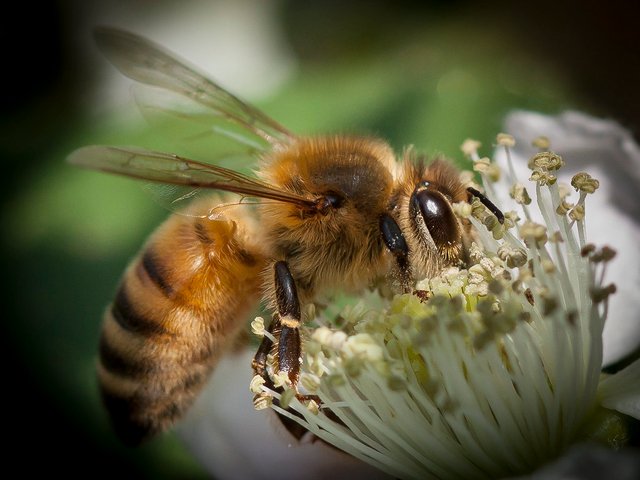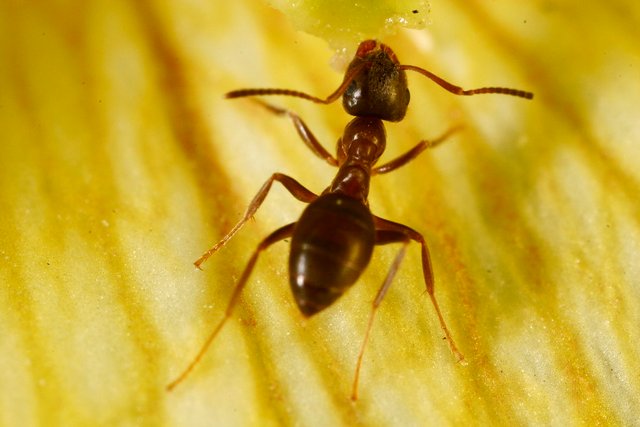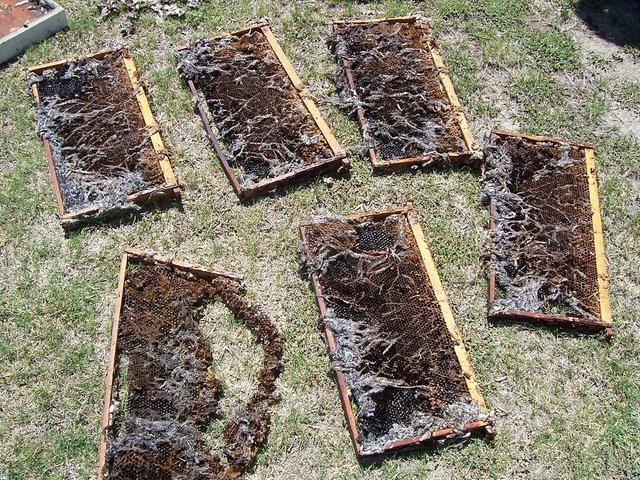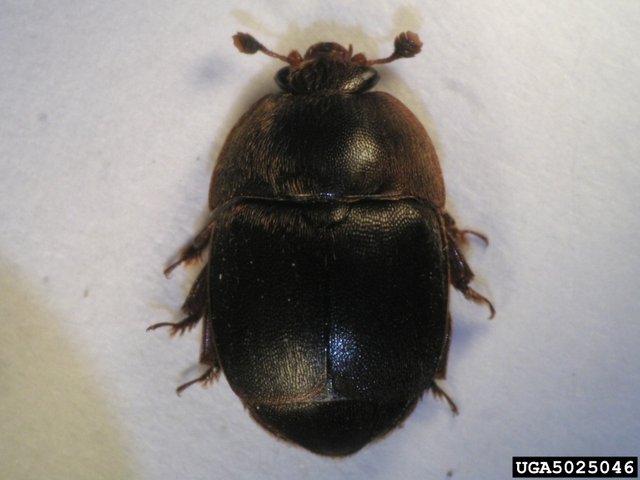Bee Problems
 "July Honey Bee" by MattX27 is licensed under CC BY-SA 2.0
"July Honey Bee" by MattX27 is licensed under CC BY-SA 2.0
Honey bee problems worldwide may or may not be at least partially due to neonicotinoid-based pesticides. The debate is ongoing. I will not address either side of that in this article.
I don't have any bees this year. I'd been keeping bees for probably five years but lost my last hive last spring. I was going to get some more this spring but moved to town and don't know their take on the subject just yet. I'm planning on getting a few packages next spring and if I have to, I'll set up my bee yard somewhere else.
A few years back I went to visit my dad. He had one hive of bees. At first I was terrified. I had gotten stung in the corner of the eye by a carpenter bee when I was in school. I had to go to school the next day with my eye swollen shut. I took a fair amount of ribbing for it.
Over the next few months I was able to go to my dad's bee yard several times and eventually stopped wearing a veil.
I decided that I wanted some bees too and started looking at plans for hives. I found WranglerStar on YouTube and saw that he had built a top bar hive. I took some notes and built one for myself.
I paid a visit to Weeks Honey to get some first-hand information on raising bees. I forget the name of guy who owns the place, but he took about a half hour to talk with me. He said that he didn't have time to mentor me but suggested a book. He said that he'd read hundreds of books on the subject and the best hands down for a beginner was Beekeeping for Dummies. It had everything you needed to know without a lot of extraneous filler.
It tells you how to tell drones from workers from queens. It has chapters on hive construction. It has chapters on one or two illness that bees commonly contract as well as natural pests.
Fire ants
 "Ants eating pollen" by Bill Hails is licensed under CC BY-ND 2.0
"Ants eating pollen" by Bill Hails is licensed under CC BY-ND 2.0
Fire ants were not covered in the book, but I soon found they could be troublesome.
We noticed one day that there was no activity around my dad's hive. Upon opening that hive we found that it was infested with fire ants!
They had killed or driven off the healthy bees. They were meticulously going through the hive and removing capped and uncapped larvae. They had even started uncapping the honey and were transporting that back to their nest.
We were unable to recover any honey from the hive. We did, however, get a few pounds of wax.
I realized that day that if I needed frames cleaned out that I could put them near a fire ant bed and let them take a few days and take care of it for me.
With a little research I discovered that if powdered cinnamon is sprinkled in and around hives ants will not bother it. They apparently do not like the smell of the spice. I also found that if the hive is on a table, the legs can be placed in cans or buckets where a little water or light oil is poured in to make a barrier the ants can't cross.
I have not had a real problem with ants since.
Wax Moth
 "Frames attacked by wax moth" by tobo is licensed under CC BY-SA 2.0
"Frames attacked by wax moth" by tobo is licensed under CC BY-SA 2.0
There are two species of wax moth (waxworm or candle flies) - the greater and the lesser. They are commercially raised and the larvae are used as a food source for humans and animals especially lizards. They are particularly high in fat content. (I cannot attest to how they taste. I have, however tried freeze-dried mealworms. They have kind of a nutty flavor.)
Wax moths are a nuisance but don't necessarily cause the collapse of a colony. They are, however, an indicator of the health of a hive. A strong hive is capable of driving off the female moths who lay their eggs near the hive entrance or small crevices that may allow access to the hive. A healthy hive will also evict any invading larvae that are found.
Weak, unhealthy hives tend to allow the larvae to grow and possibly destroy drawn honeycomb.
The larvae burrow through the comb into brood, pollen and honey cells. This kills young bee brood and larvae feces contaminates any honey that they come in contact with.
I have noticed a moth cocoon occasionally in my hives. They are eliminated post haste to help quell population growth.
Wax moths can be distracted from hives. In my research of the moths, I found that one might place banana peels and a small amount of white vinegar in a bottle near the hives. The aroma wafting from this concoction seems to be more enticing to the insects than that of beeswax. They go into the container and cannot get out or drown.
Small Hive Beetle
The small hive beetle is the worst pest that I have had to deal with. I lost my last hive to them last spring.
I heard a swarm in the area and went to check on my hive only to find that the swarm I heard was probably mine absconding. This was a top bar hive not the Langstroth that most Americans are used to seeing. A comparison of the two here. The hive had cross comb throughout and was not easy to monitor.
When I did get the hive open and saw the bottom was covered in larvae, I was disgusted and burned everything to destroy the invaders.
SHB are native to sub-Saharan Africa but showed up in Florida in 1996.
SHB adults live in the hive. They are only about .5cm in length so they easily evade housekeeping bees by hiding in crevices or scurrying quickly around a corner. This allows them to continue mating and laying eggs.
SHB larvae cause the same damage that wax moths do but it is compounded due to the amount of beetles living in the hives.
How do they find new hives?
SHB do not wander around looking for new hives to invade. Packaged bees purchased from apiaries generally have beetles in with the bees.
When shaking frames to collect bees to sell, any SHB on the frames also get shaken into the packages. They are so small they cannot be detected in the time frame used to shake frames.
There have also been instances where SHB were detected on high speed video leaving the hive with a swarm. If a hive splits, part of the beetle population goes with the swarm.
Beetle control
There are various beetle traps on the market that have varied success. I think some DIY approaches work just as well:
- CD jewel cases with 1/4" holes drilled in the top and a thin layer of vegetable oil inside. The holes are too small for a bee to access, but large enough for a beetle to try to hide. They get in the oil and and can't get out. This device is placed at the bottom of the inside of the hive.
- A hole in the bottom of the hive body that has a jar or bottle screwed into it. Place vegetable oil in the container and screw it into the hole. #8 hardware cloth covers the hole so bees cannot access it, but the beetles can. The beetles get trapped in the container.
- Hive bodies that have no solid base but instead sit on #8 hardware cloth. The hive is placed over a water trough stocked with koi, goldfish or some kind of game fish like blue gill. When the SHB jumps off a frame to elude bees, they fall through hardware cloth into the trough and are eaten by the fish. The only drawback to this is that you have to put the hives on a bottom when the weather cools but by that time you probably have eliminated your problem.
- SHB larvae leave the hive when the time comes to pupate. They burrow into the ground underneath the hive for their metamorphosis. The ground can be treated with Heterorhabditis indica. HI is a nematode (microscopic worm) that fancies the taste of SHB pupae as well as a few other garden pests.
What else?
There are several other maladies that can affect bees including varroa mites which can be controlled with vaporized oxalic acid, tracheal mites which can be controlled with menthol, and chalk brood which requires the destruction of your hives.
I've never had to deal with any of these.
In Conclusion
Beekeeping is an entertaining hobby that can be developed to bring in extra income. All that is required is an investment of about $300 for hive bodies and a package of bees and a smoker.
I would encourage anyone to look into this. You can raise bees anywhere. I've seen them on the roadside in the country, along the interstate in urban areas and even on rooftops in the city.
Bees will live anywhere you can grow flowering plants.
This article edited from two previously posted articles on publish0x and cent

This post was shared in the Curation Collective Discord community for curators, and upvoted and resteemed by the @c-squared community account after manual review.
@c-squared runs a community witness. Please consider using one of your witness votes on us here
Downvoting a post can decrease pending rewards and make it less visible. Common reasons:
Submit
Congratulations @uthus2k! You have completed the following achievement on the Steem blockchain and have been rewarded with new badge(s) :
You can view your badges on your Steem Board and compare to others on the Steem Ranking
If you no longer want to receive notifications, reply to this comment with the word
STOPDownvoting a post can decrease pending rewards and make it less visible. Common reasons:
Submit
These were great suggestions! I like the no-nonsense home made solutions that you mentioned. Extremely helpful!
Downvoting a post can decrease pending rewards and make it less visible. Common reasons:
Submit
Thanks much!
Downvoting a post can decrease pending rewards and make it less visible. Common reasons:
Submit